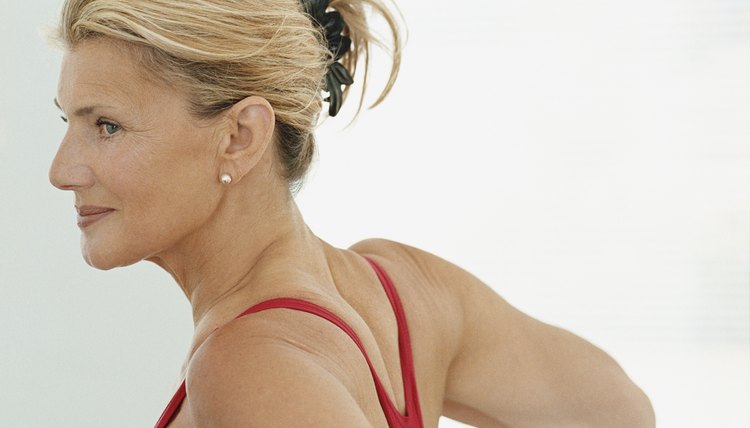The Difference Between the Shoulder Press & Incline Press

A strong chest and shoulders not only make your upper body look toned and healthy but also help you in your daily activities -- from pushing the trash can to the curb to throwing a ball to the neighbor kids. To work these areas, the classic exercises of the shoulder press and incline press should be part of your workout plan. These exercises may look similar at first glance, but they emphasize different muscle groups and require distinctive technique.
Inclination
One of the primary differences between the shoulder press and the incline press is the positioning of the body. You can perform a shoulder press from an upright seated position with your back pressed into the back of bench set perpendicular to the floor or from a standing position. An incline press is always done from a supine, or lying-down, position with the bench set at an angle of 35 to 45 degrees. The change in your body’s angle is what creates the difference in muscle activation.
Incline Press
The incline press is a variation of the flat-bench barbell press, an exercise that an October 2012 study sponsored by the American Council on Exercise named as the most effective in stimulating the muscles of the chest. For the incline variation, lie on an inclined bench and have a spotter hand you dumbbells. To perform the movement, position the dumbbells at the sides of your chest, elbows fanned slightly out to the sides. You then press the weights up simultaneously by extending the elbows completely. Lower the weights back down so the hands go to the sides of the upper chest and you feel a slight stretch in your chest and shoulders. You can also do an incline press using a barbell.
Shoulder Press
Sit on a bench with a straight back, holding a dumbbell with an overhand grip in each hand. Bring the dumbbells to each side of your shoulders and form a goal-post position with your upper arms – the elbows are bent 90 degrees and are positioned below your wrists. You then press the weight up until your elbows fully extend overhead. Lower back down to the starting position for one repetition. You can do a shoulder press using a barbell as well. The movement is the same, but if the weight is particularly heavy, you may want to set the barbell on a power rack at shoulder height when dismounting the weight. You can also perform this exercise standing, but do not lock your knees or arch your back.
Muscles Worked in the Incline
The primary focus of the incline chest press is the pectoralis major, the large fanlike muscle that makes up the front of the chest. This muscle has two heads, or points of origin: the clavicular head at the upper part of the muscle and the sternocostal head at the lower part. The incline chest press activates the clavicular head of the pectoralis major. As the incline of the bench increases, the assisting role of the anterior deltoids – the front side of the three-headed shoulder muscle – increases, according to a landmark study published in the “Journal of Strength and Conditioning Research." Your triceps muscles at the back of the upper arm also assist during the incline press.
Muscles of the Shoulder Press
The shoulder press uses the clavicular head of the pectoralis major as a stabilizer only. The primary focus of the shoulder press is the anterior head of the deltoids. When compared to the incline press, the shoulder press uses more muscles for stabilization. These are the lateral deltoid, the top cap of the shoulder; the supraspinatus, one of the muscles of the rotator cuff; the triceps at the back of the upper arm; the trapezius of the upper back; and the serratus anterior around the ribs.
Strategy
Both presses are a valuable addition to any upper body strengthening routine. If you are new to lifting, start with one set of eight to 12 repetitions of each move using a weight that makes you feel like the last couple of repetitions are very hard to do with proper form. Over the course of a few weeks, add in another set or two – resting for about 30 to 60 seconds between sets. When you can easily perform 12 repetitions of the incline press or shoulder press with the weights you’ve chosen, increase the weight by 5 to 10 percent.
Explore In Depth
References
- American Council on Exercise: ACE-Sponsored Research: Top 3 Most Effective Chest Exercises
- ExRx.net: Dumbbell Incline Bench Press
- ExRx.net: Dumbbell Shoulder Press
- Lauver JD, Cayot TE, Scheuermann BW. Influence of bench angle on upper extremity muscular activation during bench press exercise. Eur J Sport Sci. 2016;16(3):309-16. doi:10.1080/17461391.2015.1022605
- Trebs A, Brandenburg J, Pitney W. An electromyography analysis of 3 muscles surrounding the shoulder joint during the performance of a chest press exercise at several angles. J Strength Cond Res. 2010;24(7):1925-1930. doi:10.1519/jsc.0b013e3181ddfae7
- Trebs A, Brandenburg J, Pitney W. An electromyography analysis of 3 muscles surrounding the shoulder joint during the performance of a chest press exercise at several angles. J Strength Cond Res. 2010;24(7):1925-1930. doi:10.1519/jsc.0b013e3181ddfae7
Writer Bio
Andrea Cespedes is a professionally trained chef who has focused studies in nutrition. With more than 20 years of experience in the fitness industry, she coaches cycling and running and teaches Pilates and yoga. She is an American Council on Exercise-certified personal trainer, RYT-200 and has degrees from Princeton and Columbia University.
